What is traveler’s diarrhea?
I know, it’s getting gross up in here, but it’s reality.
💩 happens.
However, traveler’s diarrhea is avoidable, and chances are, it will resolve without any treatment.
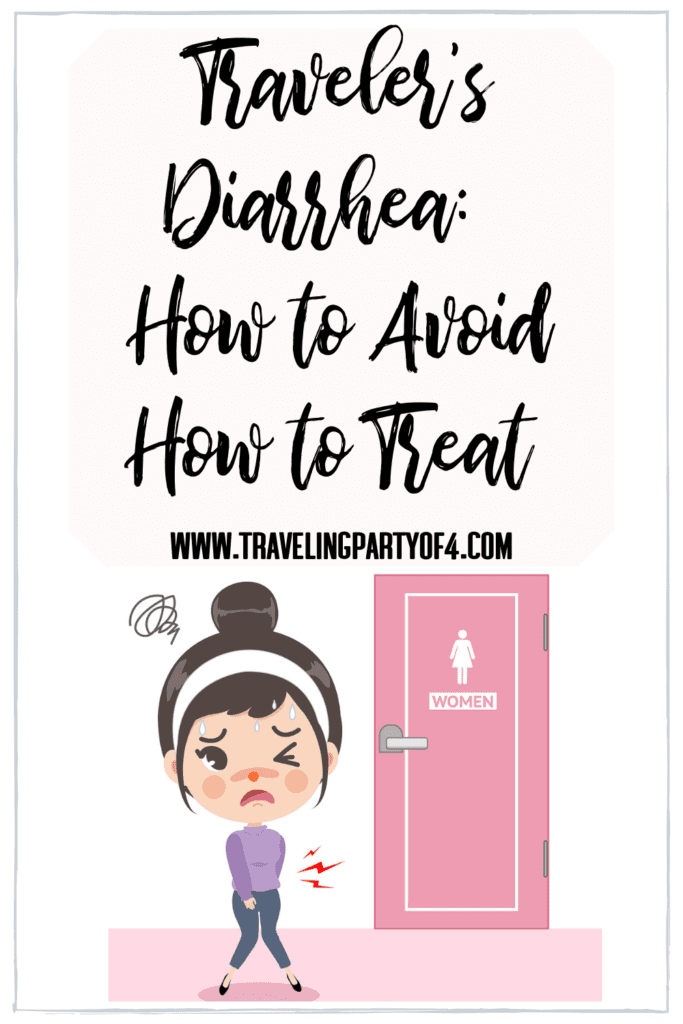
Disclaimer
** The medical information that I am sharing with you is from either from The Mayo Clinic or the Centers for Disease Control and Prevention. I am not a Physician. My purpose in writing this post and sharing this information with you is not to replace the recommendations of your health care provider. If you have any of the medical diagnoses that I have listed, which place you at high risk of traveler’s diarrhea, or you are prone to traveler’s diarrhea, then you need to discuss preventive strategies while traveling with your doctor.**
According to the Mayo Clinic Website, traveler’s diarrhea is a digestive tract disorder that commonly causes loose stools and abdominal cramps. It’s caused by eating contaminated food or drinking contaminated water.
Traveler’s diarrhea can be caused by the stress of traveling to a new place and eating different foods. However, about 80% is caused by an infection either bacterial (most common), viral, or protozoal.

I figured since I have been researching and writing a lot about health, fitness, and safety while traveling, that I needed to address this one, too. Sorry if it is gross, but you need to be aware because it is one of the most common travel-related ailments.
Affiliate Disclosure: There are affiliate links throughout this post. This means if you click on a link and purchase a product through that link, then I will receive a small commission for the referral. And that is kinda cool.
- What is traveler’s diarrhea?
- Diarrhea by any other name…
- Symptoms of traveler’s diarrhea.
- If your child develops traveler’s diarrhea, you will need to be extra vigilant.
- Who is at high risk for developing traveler’s diarrhea?
- Tips for the prevention of traveler’s diarrhea.
- If you develop traveler’s diarrhea, here is what to do.
- How to be prepared for traveler’s diarrhea (let’s call it a SH!T K!T).
- Purchase traveler’s insurance.
Diarrhea by any other name…
- Montezuma’s revenge.
- Delhi Belly.
- Traveler’s Tummy.
- Get Out Of Town Gut.
- Rangoon Runs.
- Soupy Stomach.
- Trip Trots.
OK, I might have made up a couple of those, but they’re funny.

Symptoms of traveler’s diarrhea.
- Diarrhea. Watery and maybe even explosive. 💥
- Bowel urgency, or abrupt need to poop.
- Cramping in your abdomen.
- Bloating.
- Nausea, vomiting.
- Fevers/chills/sweats.
- Increased volume of stools.
- Bloody or mucousy stool.
Most likely, these symptoms will resolve within a few days.
However, seek prompt medical attention for the following reasons:
- If diarrhea, nausea, and vomiting last for more than two days.
- Your diarrhea turns bloody or black.
- Seek medical attention immediately if your abdominal or rectal pain becomes severe or unbearable.
- Or if your fever is more than 102 degrees Fahrenheit.
- Dehydration ~ You can evaluate for dehydration by pinching the skin on the top of your hand. If the skin remains in a “tent,” this is a sign of dehydration.
It is important to note that the complications from dehydration can be serious and even life-threatening, ranging from profound malaise and electrolyte disturbances to seizures, cardiac arrhythmias, and kidney malfunction.
If your child develops traveler’s diarrhea, you will need to be extra vigilant.
Children are prone to dehydration much quicker than adults when they are vomiting, having diarrhea, or they have high fevers. You will need to seek medical attention for the following if your child becomes sick.
- Dehydration ~ Check for tenting, the same way you would check an adult. Pinch the skin on the top of their hand, if the skin stays in a “tent, ” this is a sign of dehydration.
- Crying with no tears, dry mouth ~ These are other signs that the child has become dehydrated.
- Decrease urine output. In a baby, fewer wet diapers.
- Dizziness. Drowsiness. Or unresponsiveness.
- High fevers (102 Degrees Fahrenheit).
- Confusion.
- Bloody or black stools.
Who is at high risk for developing traveler’s diarrhea?
Besides anyone who travels!
There are regions around the world that have a higher incidence of traveler’s diarrhea.
These include Central and South America, Mexico, The Middle East, Asia, and Africa.
And there are certain groups of people who are at a higher risk.
Young adults, for example, tend to experience traveler’s diarrhea more frequently than older travelers. Pre-existing medical issues will place a person at high risk; for example, a person with a weakened immune system, diabetics, cirrhotics, and people with inflammatory bowel disease.
Acid reducing medications.
A person who is on an acid-reducing medication (ranitidine, famotidine, Tums) has a higher risk. The acid in the stomach can potentially destroy the organism causing the problem. So, by reducing acid in your stomach, the environment becomes more conducive to bacterial survival and growth.
And I must say, if you’ve had it once, you will probably have it again (at least, that is how it is in this family).
That is unless you do a few things to decrease your risk.
Tips for the prevention of traveler’s diarrhea.
Starting with food safety.
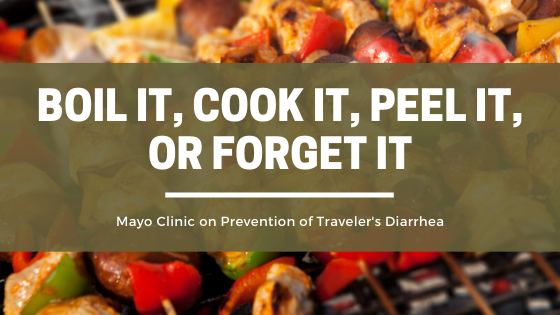
- Hot food is usually ok because high heat kills germs that may cause traveler’s diarrhea.
- Avoid raw or undercooked food; this goes for runny eggs as well.
- Fruit and vegetables, if washed thoroughly and peeled and cut by you, are generally safe. Avoid fruit platters cut by others, and salsas made with fresh ingredients. Careful with fruits with thin skin that cannot be peeled (strawberries, blackberries, grapes).
- Avoid fresh fruit juices.
- Dairy products must be pasteurized.
- Nuts and other shelled foods are usually safe unless there are food allergies.
- Salads/lettuce, I avoid unless I have made it myself.
- Street foods, I know this is fun, but be careful. If you see it come hot and steaming off of the grill, then go for it.
- Tap water is risky in many countries; this goes for ice, too. Water, sports drinks, sparkling water, sodas from a sealed bottle are the safest.
- Drink canned and bottled beverages only if you have opened them yourself. Make sure to wipe off the can or bottle before opening.
- Hot coffees and hot teas, if served steaming hot.
- Beer and wine are usually safe, but, make sure to wipe off the can or bottle before opening.
And a few on water safety.
If you are in a high-risk area, then…
- Drink bottled water or water that has been boiled or sterilized. When you purchase bottled water, make sure the cap has not been tampered with or opened and resealed.
- Avoid ice and tap water.
- Keep your mouth closed while in the shower.
- Avoid unsterilized water and tap water. If you must drink tap water, boil it before consuming it.
- Use bottled water when you brush your teeth and contact lens cleaning.
- Always order hot beverages, such as coffee and tea. Make sure they are steaming hot.
Consider packing water purifying tablets. Aquatabs are the only water purification tablet with an approved formula for routine use by the World Health Organization (WHO). The effervescent tablets kill microorganisms in water including cholera, typhoid, and dysentery.
Probiotics ~ I have spent time researching probiotics to find definitive evidence that they work for the prevention of traveler’s diarrhea. Unfortunately, the evidence is underwhelming. Some studies say they work, and some say they do not. However, it does not hurt to try it.
When you are experiencing GI upset and diarrhea, your gut microbes are thrown off and probiotics can help get them back on track. You can also find probiotics in yogurt, Kefir, Kombucha, and fermented foods (sauerkraut, Tempeh, Kimchi, and Miso).
And, always, always, always WASH YOUR HANDS WITH SOAP AND WATER.
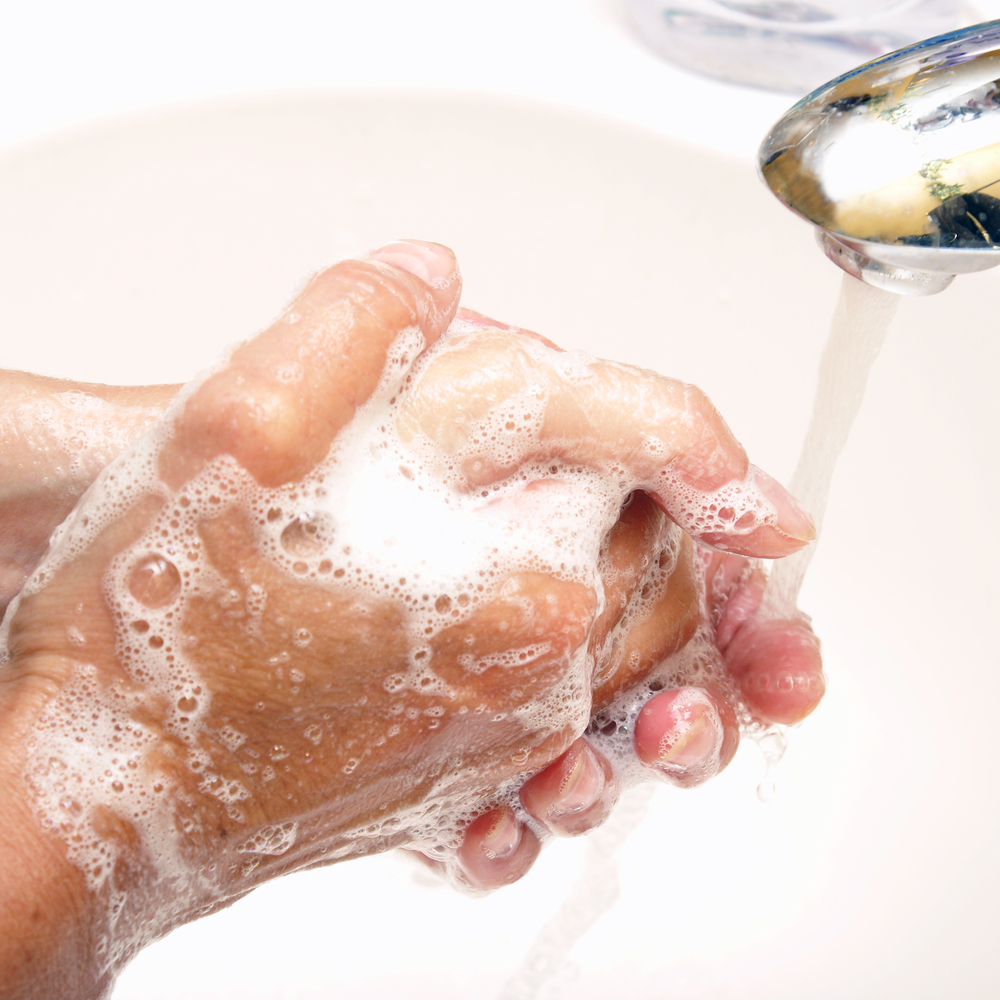
If you develop traveler’s diarrhea, here is what to do.
Rehydrate.
But, make sure you rehydrate safely. Use boiled water, hot broth, and a rehydration solution such as Pedialyte, but make sure you mix with a safe solution such as boiled water. Gatorade is full of electrolytes and has a safety seal.
Avoid caffeinated drinks as they can increase fluid loss due to the diuretic effect.
There are multiple types of rehydration packets available on Amazon. Check them out below. If you are traveling to a high-risk region, take these with you.
DiaResQ ~ I came across DiaResQ while researching traveler’s diarrhea for this post. I have not used DiaResQ, but it comes highly recommended, and multiple travel bloggers are using this product.
According to the packaging, DiaResQ is “food made from naturally derived ingredients that effectively reach the intestine to restore normal function rapidly. It delivers important nutrients and other, naturally concentrated ingredients to support digestive health and rapidly restores intestinal function for fast relief.”
DiaResQ provides nutrients to people who are experiencing diarrhea. It comes in convenient travel packets. And has a children’s dose, too.
Medication.
Antidiarrheals/Antimotility Agents.
Imodium ~ Imodium is an over-the-counter medication used to slow down diarrhea. While Imodium does not treat the cause of diarrhea, it will help with the associated discomfort.
Pepto Bismol (not to be taken if you have an aspirin allergy) ~ Typically used for stomach upset, but helps with diarrhea, too. Be aware that side effects include black stool and black tongue. Pepto Bismol has been studied in the prevention of traveler’s diarrhea using two ounces of liquid or two chewable tablets four times a day. The results have shown a 50% reduction in the incidence of traveler’s diarrhea.
Antimotility agents are not recommended if you are experiencing bloody stools or fevers.
Antibiotics ~ An antibiotic may be prescribed for traveler’s diarrhea, especially if your diarrhea progresses to more than four loose stools per day or more severe symptoms such as bloody stools, pus, or mucus in the stool. If you are traveling to a high-risk region, discuss this with your physician who can prescribe an antibiotic to take with you to only use for severe symptoms.
Once you begin recovering, try this.
- BRAT Diet ~ Bananas, Rice, Applesauce, Toast.
- Or other bland foods such as saltines, potatoes, plain noodles.
- Canned chicken noodle soup is our favorite.
How to be prepared for traveler’s diarrhea (let’s call it a SH!T K!T).
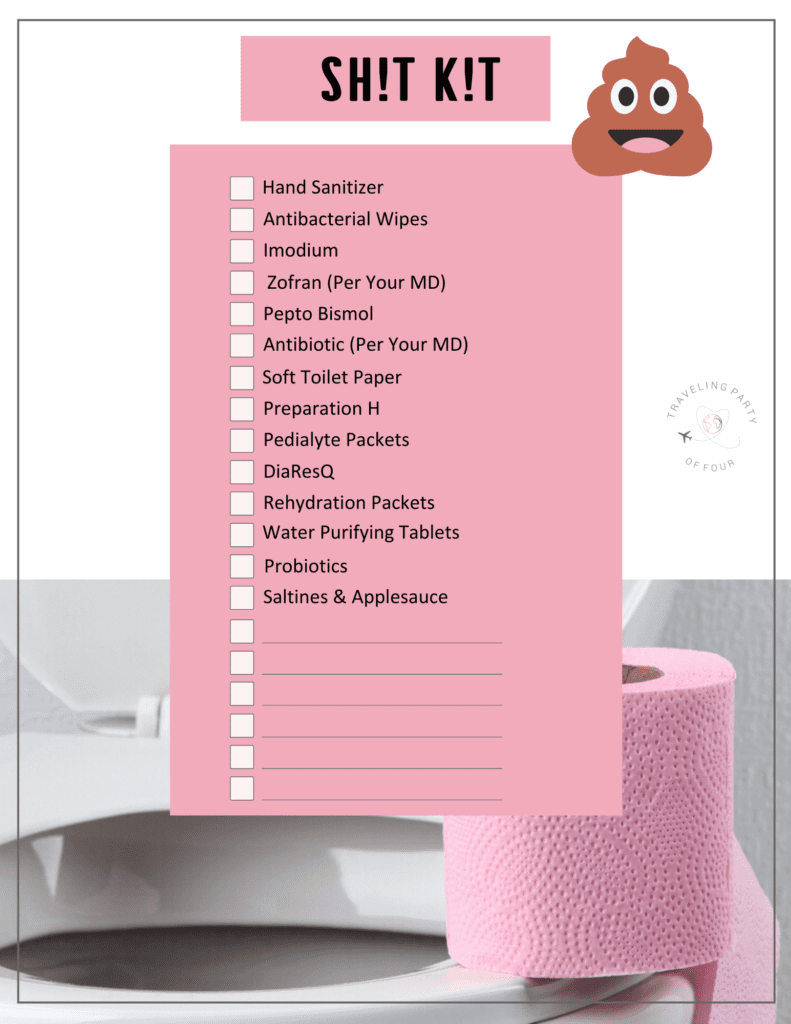
Purchase traveler’s insurance.
With World Nomads, you can purchase AND claim from anywhere in the world. Plus, 24/7 emergency assistance, including emergency evacuation, as well as coverage for over 200 adventure activities. And I love the World Nomads Website. It is full of information and looks like a travel blog full of safety advice and travel inspiration.
Sorry that I had to get all gross on you, but traveler’s diarrhea happens. Now you are prepared.
For more important information on travel-related ailments, check out this e-book from ETSY. You can’t always avoid experiencing travel-related illnesses. Knowing how to recognize and manage the symptoms is essential to your peace of mind.
The ailments that I have included in this E-Book are the most common issues travelers face. The cause, symptoms, and treatments of the illness are all covered. Plus, preventive measures you can begin to prepare for during the planning phase of your adventure.
Here are the most common travel-related ailments included in the E-Book sold for $7 on ETSY.
- Airport Anxiety
- Jet Lag
- Seasickness
- Altitude Sickness
- Insomnia
- Heat-Related Illness
- Traveler’s Diarrhea
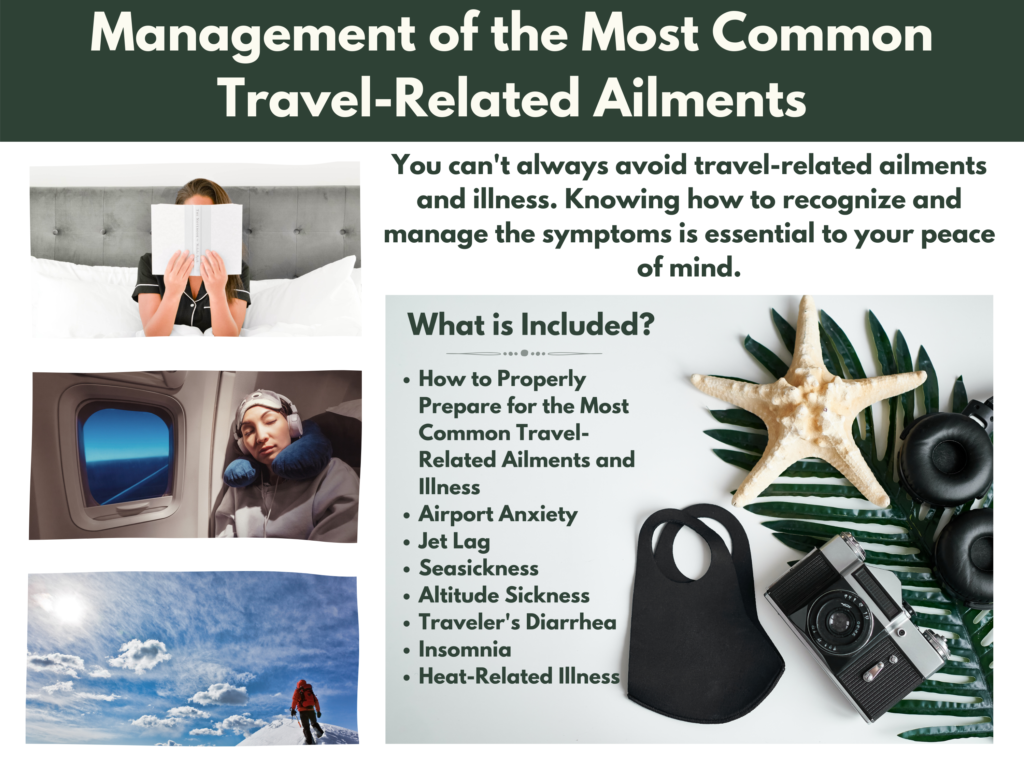
Enjoy your adventure, explore the local culture, try new things, and have a blast. But, take precautions and be smart about the food and drinks you consume.
Thankfully, traveler’s diarrhea can be avoided and chances are, it will resolve without any treatment.













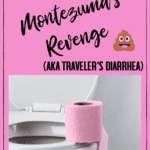
Well, I’ve never had this, but I’ve known people who have gotten this. I love all your tips to alleviate it. I chuckled when I saw the unicorn and its rainbow turd. LOL
I did, too. I had to use it, too irresistible. Someone in our family always has it, but with us, it is usually related to rich food.
I know it’s a yikes moment but I agree, it happens! I love traveling but I will no go without baby wipes, hydralyte and imodium (or something similar) in my hand luggage. Thanks so much for your tips as well.
I agree, 100%. I never travel without those things either.
Great advice! I always have digestive issues when traveling due to a lot of food sensitivities. When traveling I take activated charcoal before meals. It seems to really help. It also can absorb nutrients though, so I wouldn’t recommend taking it all the time. But, it could help you have a better vacation!
I have read about that, too. I will look into it and consider adding it to my list. Thanks for the tip.
As someone who has traveled avidly, I so appreciate the candour and informative approach to this post! Many thanks!
You are welcome. It happens to the best of us!
Hahaha love the sh*t kit! Better to be prepared right? This post made me laugh out loud at times!
I know, I was laughing the entire time. I was gonna tell a story, but it got too gross. 😝
Interesting tips, love the Sh!t Kit!
Yep, we all need one. You never know!
I am usually careful when I travel and avoid questionable food but that sometimes isn’t enough. I travel with a medkit and antibiotics + antidiarrheals are always included. I hope to never use them but on occasion, the antidiarrheals have gotten very low.
Me, too. We never leave home without the antidiarrheals, even in town.
Urghh sharm el sheikh. Had it about an hour before boarding to cairo. Luckily i had some immodium which sorted me out. Quite common out there i believe
You made me LOL, yuk! But, it happens to the best of us.
This is a really good overview of the bane of my travels. I’m a sucker for street food.
Please be careful about taking Cipro— lots of research on side effects.
Agree. Antibiotics only when necessary. And I am, too. I love the experience of trying different cuisines, but sometimes it doesn’t love me back!
I have yet to have it but I know plenty of people who have. All great tips and especially important to stay hydrated!
Yes, for sure.
Luckily I haven’t met diarrhea, but it’s definitely very important to know about it! I didn’t know many things and I am happy that you wrote this post and I don’t think that it’s grossly or something like that. As you said – that’s our reality! It can happen to all of us! Better to be prepared! Thanks!
Yes, it happens to the best of us. Best to be prepared.
These are great tips for managing travelers diarrhea, I’m always a big fan of the BRAT diet any time my kids have stomach troubles. Also, I am dying at the list of nicknames — I’ve never heard of most of those before. You learn something new every day, lol.
I might have made a couple of those names up! They’re funny, though. I learned about the BRAT diet in nursing school. It has come in handy many times over the years.
Honestly, this is a pretty important topic and more traumatizing to deal with because you’re traveling! I love the tips to combat it when on the road so there’s a plan of action and you can prepare. My favorite is the SH!T K!T!
I thought it was kinda funny, in the midst of a distressing topic. I am always prepared, as someone in this family inevitably gets something while we are traveling.
Great tips! I always eat what we cook or prepare a night before, and only go out to restaurants if I know we will stay in the same place for couple of days. So, if unaccepted happens I know where to run. 😉
One tip: I introduced kefir, sourcrout, etc. to my husband little by little, because he didn’t grow up with these probiotics and I knew his stomach has to get used to them. They are super healthy though. (in my opinion)
I haven’t tried any of that, probably a good time to start. Thank you for the recommendation.
Traveling makes me super anxious so I can relate lol. I will have to keep these tips in mind for next time. I would love to have travel be a more pleasant experience.
I used to be super anxious, too, especially in a terminal and on an airplane. I have improved so much over the years, and I have actually enjoyed our last few flights.
Excellent post! When I was a child I would get such anxiety going to a new store or place that as soon as we got there I would have diarrhea. It has gotten better, but I will not forget it.
I’m with you. Anxiety always does that to me. Blahhh.